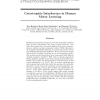69 search results - page 13 / 14 » An architecture for biological information extraction and re... |
DAGM
2003
Springer
14 years 20 days ago
2003
Springer
We introduce a computational model of sensor fusion based on the topographic representations of a ”two-microphone and one camera” configuration. Our aim is to perform a robust...
BC
2005
13 years 7 months ago
2005
Abstract Weproposeacomputationalmodelofcontourintegration for visual saliency. The model uses biologically plausible devices to simulate how the representations of elements aligned...
BMCBI
2011
13 years 1 months ago
2011
Background: Automated, image based high-content screening is a fundamental tool for discovery in biological science. Modern robotic fluorescence microscopes are able to capture th...
NIPS
1994
13 years 8 months ago
1994
Biological sensorimotor systems are not static maps that transform input sensory information into output motor behavior. Evidence from many lines of research suggests that their r...
BIOSYSTEMS
2008
13 years 7 months ago
2008
The responses of cortical neurons are often characterized by measuring their spectro-temporal receptive fields (strfs). The strf of a cell can be thought of as a representation of...

